Research Methodology: Outsourcing Business Functions - Advantages
VerifiedAdded on 2023/06/14
|13
|2756
|488
Report
AI Summary
This research report investigates the advantages and disadvantages of outsourcing business functions, focusing on its impact on organizational performance. It employs both qualitative and quantitative research methodologies, including literature reviews, interviews with managers, and statistical analysis. The study examines the concept of outsourcing, its benefits such as cost reduction and focus on core activities, and its drawbacks including potential cultural issues and impact on domestic job markets. The research uses primary and secondary data, with variables specified as outsourcing (independent) and organizational performance (dependent). The report concludes that while outsourcing can enhance business growth, careful consideration of its limitations and strategic implementation are crucial for success. Desklib provides access to this and other solved assignments for students.
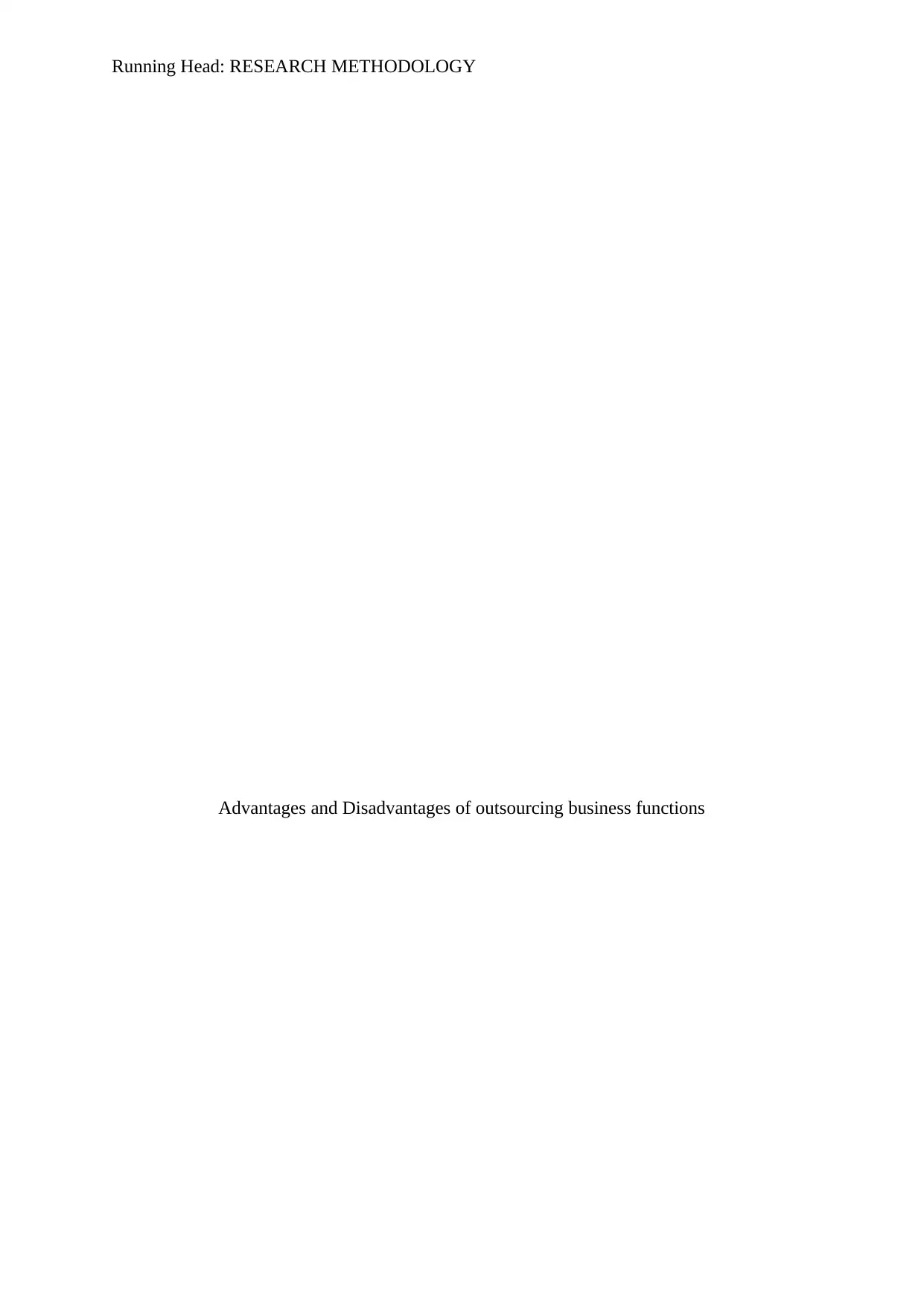
Running Head: RESEARCH METHODOLOGY
Advantages and Disadvantages of outsourcing business functions
Advantages and Disadvantages of outsourcing business functions
Paraphrase This Document
Need a fresh take? Get an instant paraphrase of this document with our AI Paraphraser
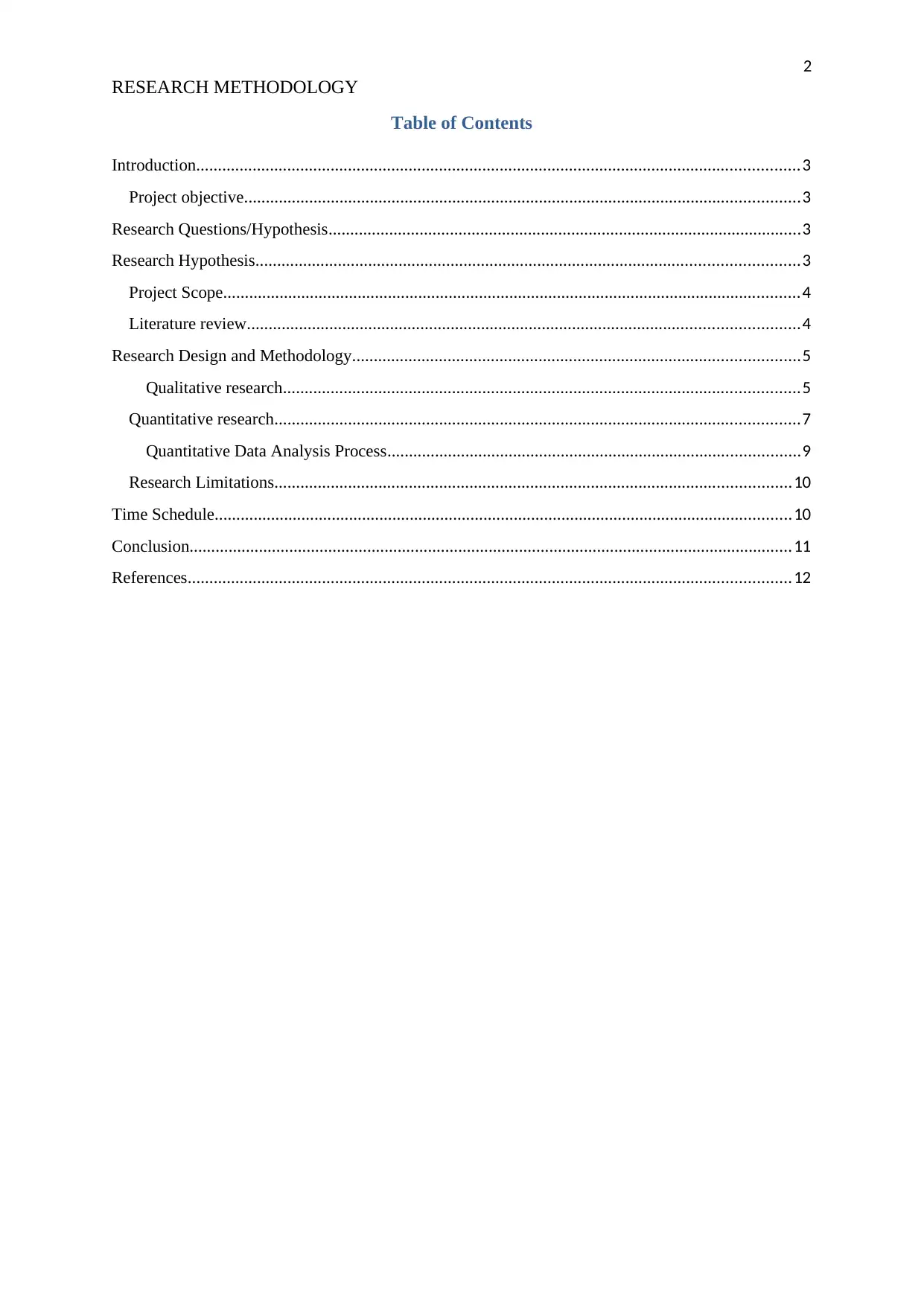
2
RESEARCH METHODOLOGY
Table of Contents
Introduction...........................................................................................................................................3
Project objective................................................................................................................................3
Research Questions/Hypothesis.............................................................................................................3
Research Hypothesis.............................................................................................................................3
Project Scope.....................................................................................................................................4
Literature review...............................................................................................................................4
Research Design and Methodology.......................................................................................................5
Qualitative research.......................................................................................................................5
Quantitative research.........................................................................................................................7
Quantitative Data Analysis Process...............................................................................................9
Research Limitations.......................................................................................................................10
Time Schedule.....................................................................................................................................10
Conclusion...........................................................................................................................................11
References...........................................................................................................................................12
RESEARCH METHODOLOGY
Table of Contents
Introduction...........................................................................................................................................3
Project objective................................................................................................................................3
Research Questions/Hypothesis.............................................................................................................3
Research Hypothesis.............................................................................................................................3
Project Scope.....................................................................................................................................4
Literature review...............................................................................................................................4
Research Design and Methodology.......................................................................................................5
Qualitative research.......................................................................................................................5
Quantitative research.........................................................................................................................7
Quantitative Data Analysis Process...............................................................................................9
Research Limitations.......................................................................................................................10
Time Schedule.....................................................................................................................................10
Conclusion...........................................................................................................................................11
References...........................................................................................................................................12

3
RESEARCH METHODOLOGY
Introduction
Outsourcing is a process that enables the organization to concentrate on primary main
activities of business rather than wasting their time on ordinary activities. It supports to
enhance the overall performance of the organization (Taylor, et al., 2015). For example, IBM
outsources their business activities and ensures their employees to consider primary activities
and enhance the existing financial situation of the firm. This report discusses the project
scope and research methodology. The research design supports to gain understanding about
certain techniques that facilitate to accomplish specified objectives of the research.
Project objective
The main aim of this research is to address the advantages and disadvantages of outsourcing
business functions. The following objectives are used by research scholar to attain the
research aim:
To explore the meaning and concept of outsourcing business functions.
To discover advantages of outsourcing business functions.
To examine disadvantages of outsourcing business functions.
Research Questions/Hypothesis
What is the meaning and concept of outsourcing business functions?
What are the benefits or advantages of outsourcing business functions?
What are cons of outsourcing business functions?
Research Hypothesis
Null hypothesis: Ho: There is significant relationship outsourcing and organization
performance
Alternative hypothesis: H1: There is no significant relationship between the outsourcing and
organization performance
RESEARCH METHODOLOGY
Introduction
Outsourcing is a process that enables the organization to concentrate on primary main
activities of business rather than wasting their time on ordinary activities. It supports to
enhance the overall performance of the organization (Taylor, et al., 2015). For example, IBM
outsources their business activities and ensures their employees to consider primary activities
and enhance the existing financial situation of the firm. This report discusses the project
scope and research methodology. The research design supports to gain understanding about
certain techniques that facilitate to accomplish specified objectives of the research.
Project objective
The main aim of this research is to address the advantages and disadvantages of outsourcing
business functions. The following objectives are used by research scholar to attain the
research aim:
To explore the meaning and concept of outsourcing business functions.
To discover advantages of outsourcing business functions.
To examine disadvantages of outsourcing business functions.
Research Questions/Hypothesis
What is the meaning and concept of outsourcing business functions?
What are the benefits or advantages of outsourcing business functions?
What are cons of outsourcing business functions?
Research Hypothesis
Null hypothesis: Ho: There is significant relationship outsourcing and organization
performance
Alternative hypothesis: H1: There is no significant relationship between the outsourcing and
organization performance
⊘ This is a preview!⊘
Do you want full access?
Subscribe today to unlock all pages.

Trusted by 1+ million students worldwide
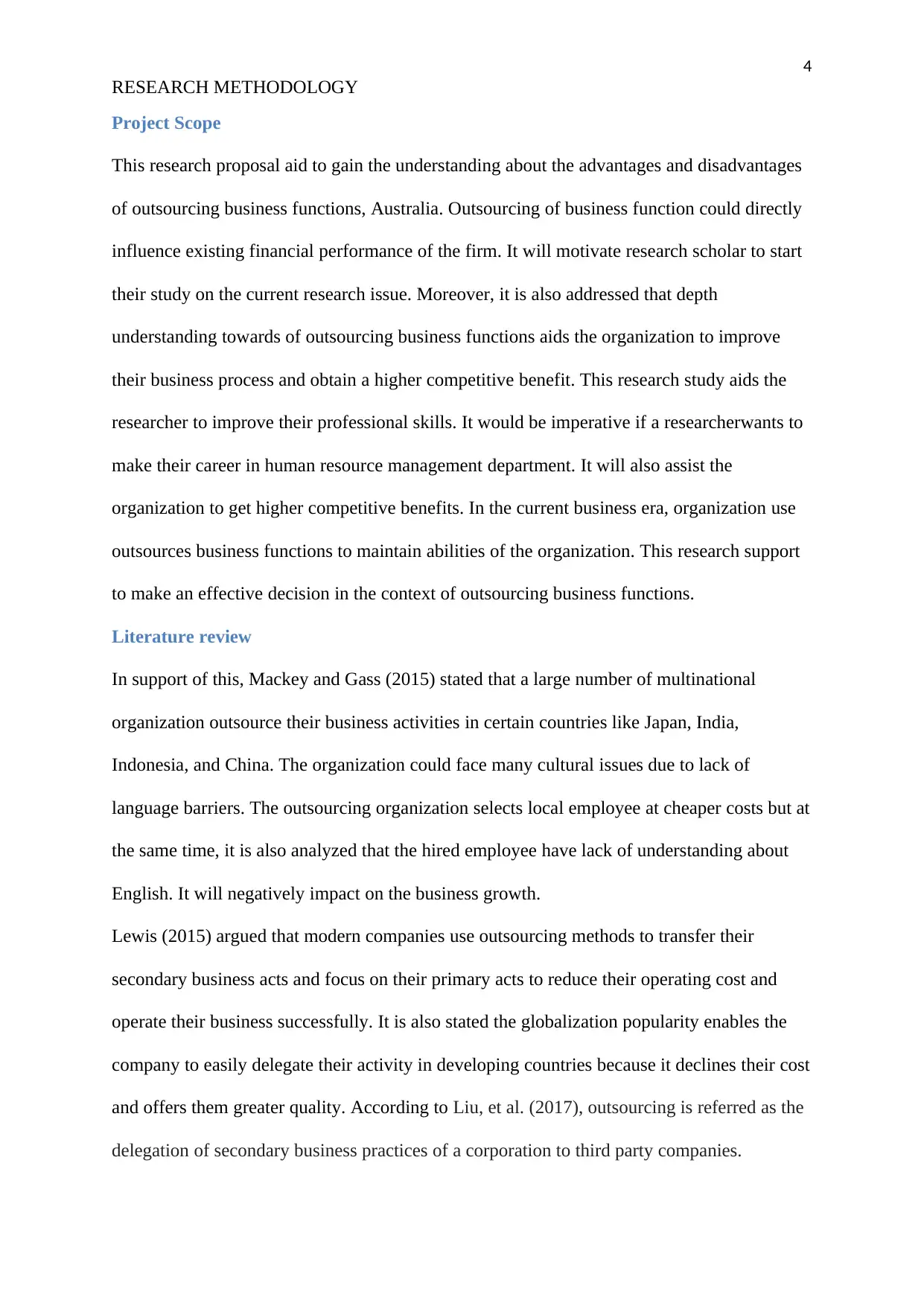
4
RESEARCH METHODOLOGY
Project Scope
This research proposal aid to gain the understanding about the advantages and disadvantages
of outsourcing business functions, Australia. Outsourcing of business function could directly
influence existing financial performance of the firm. It will motivate research scholar to start
their study on the current research issue. Moreover, it is also addressed that depth
understanding towards of outsourcing business functions aids the organization to improve
their business process and obtain a higher competitive benefit. This research study aids the
researcher to improve their professional skills. It would be imperative if a researcherwants to
make their career in human resource management department. It will also assist the
organization to get higher competitive benefits. In the current business era, organization use
outsources business functions to maintain abilities of the organization. This research support
to make an effective decision in the context of outsourcing business functions.
Literature review
In support of this, Mackey and Gass (2015) stated that a large number of multinational
organization outsource their business activities in certain countries like Japan, India,
Indonesia, and China. The organization could face many cultural issues due to lack of
language barriers. The outsourcing organization selects local employee at cheaper costs but at
the same time, it is also analyzed that the hired employee have lack of understanding about
English. It will negatively impact on the business growth.
Lewis (2015) argued that modern companies use outsourcing methods to transfer their
secondary business acts and focus on their primary acts to reduce their operating cost and
operate their business successfully. It is also stated the globalization popularity enables the
company to easily delegate their activity in developing countries because it declines their cost
and offers them greater quality. According to Liu, et al. (2017), outsourcing is referred as the
delegation of secondary business practices of a corporation to third party companies.
RESEARCH METHODOLOGY
Project Scope
This research proposal aid to gain the understanding about the advantages and disadvantages
of outsourcing business functions, Australia. Outsourcing of business function could directly
influence existing financial performance of the firm. It will motivate research scholar to start
their study on the current research issue. Moreover, it is also addressed that depth
understanding towards of outsourcing business functions aids the organization to improve
their business process and obtain a higher competitive benefit. This research study aids the
researcher to improve their professional skills. It would be imperative if a researcherwants to
make their career in human resource management department. It will also assist the
organization to get higher competitive benefits. In the current business era, organization use
outsources business functions to maintain abilities of the organization. This research support
to make an effective decision in the context of outsourcing business functions.
Literature review
In support of this, Mackey and Gass (2015) stated that a large number of multinational
organization outsource their business activities in certain countries like Japan, India,
Indonesia, and China. The organization could face many cultural issues due to lack of
language barriers. The outsourcing organization selects local employee at cheaper costs but at
the same time, it is also analyzed that the hired employee have lack of understanding about
English. It will negatively impact on the business growth.
Lewis (2015) argued that modern companies use outsourcing methods to transfer their
secondary business acts and focus on their primary acts to reduce their operating cost and
operate their business successfully. It is also stated the globalization popularity enables the
company to easily delegate their activity in developing countries because it declines their cost
and offers them greater quality. According to Liu, et al. (2017), outsourcing is referred as the
delegation of secondary business practices of a corporation to third party companies.
Paraphrase This Document
Need a fresh take? Get an instant paraphrase of this document with our AI Paraphraser
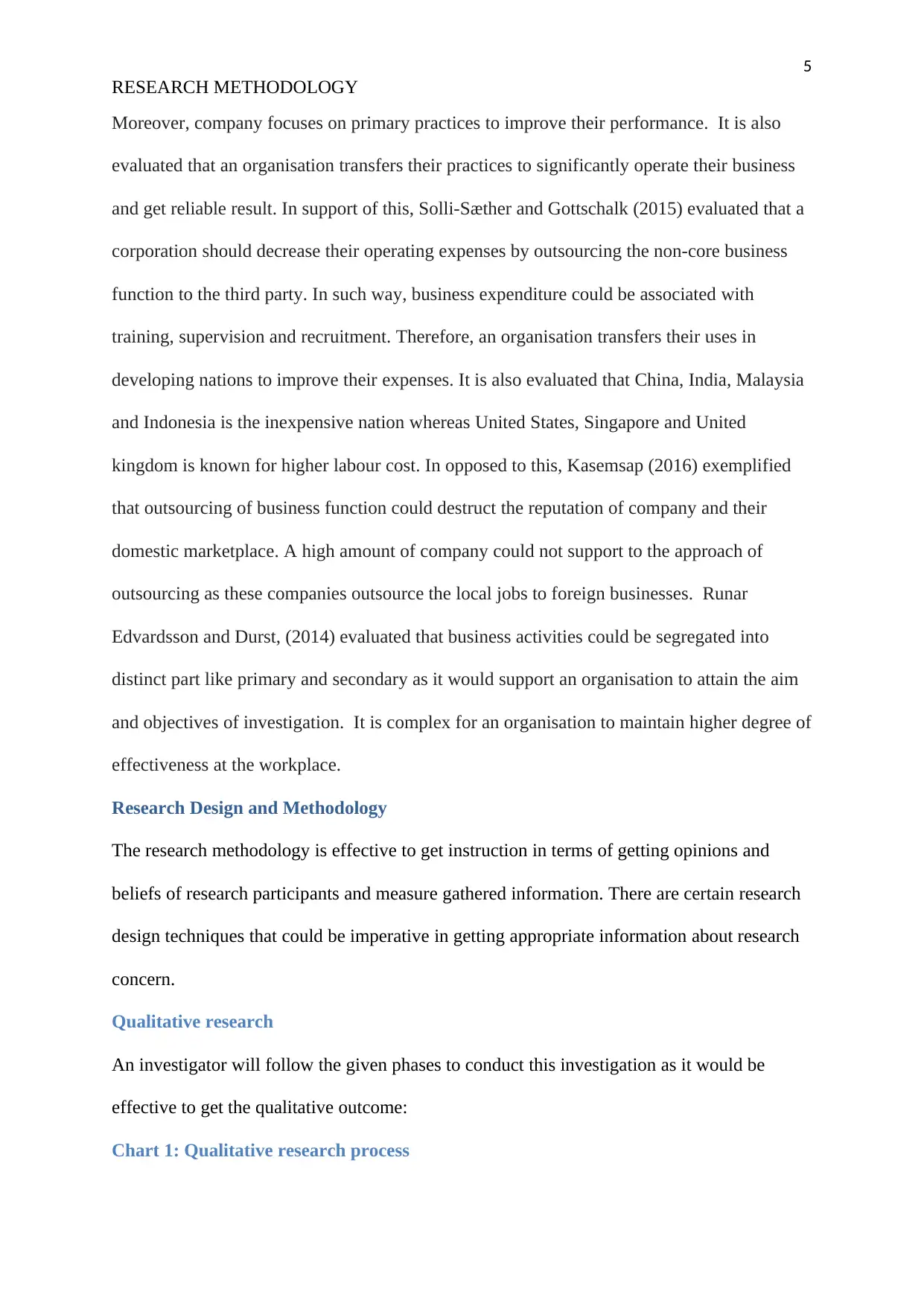
5
RESEARCH METHODOLOGY
Moreover, company focuses on primary practices to improve their performance. It is also
evaluated that an organisation transfers their practices to significantly operate their business
and get reliable result. In support of this, Solli-Sæther and Gottschalk (2015) evaluated that a
corporation should decrease their operating expenses by outsourcing the non-core business
function to the third party. In such way, business expenditure could be associated with
training, supervision and recruitment. Therefore, an organisation transfers their uses in
developing nations to improve their expenses. It is also evaluated that China, India, Malaysia
and Indonesia is the inexpensive nation whereas United States, Singapore and United
kingdom is known for higher labour cost. In opposed to this, Kasemsap (2016) exemplified
that outsourcing of business function could destruct the reputation of company and their
domestic marketplace. A high amount of company could not support to the approach of
outsourcing as these companies outsource the local jobs to foreign businesses. Runar
Edvardsson and Durst, (2014) evaluated that business activities could be segregated into
distinct part like primary and secondary as it would support an organisation to attain the aim
and objectives of investigation. It is complex for an organisation to maintain higher degree of
effectiveness at the workplace.
Research Design and Methodology
The research methodology is effective to get instruction in terms of getting opinions and
beliefs of research participants and measure gathered information. There are certain research
design techniques that could be imperative in getting appropriate information about research
concern.
Qualitative research
An investigator will follow the given phases to conduct this investigation as it would be
effective to get the qualitative outcome:
Chart 1: Qualitative research process
RESEARCH METHODOLOGY
Moreover, company focuses on primary practices to improve their performance. It is also
evaluated that an organisation transfers their practices to significantly operate their business
and get reliable result. In support of this, Solli-Sæther and Gottschalk (2015) evaluated that a
corporation should decrease their operating expenses by outsourcing the non-core business
function to the third party. In such way, business expenditure could be associated with
training, supervision and recruitment. Therefore, an organisation transfers their uses in
developing nations to improve their expenses. It is also evaluated that China, India, Malaysia
and Indonesia is the inexpensive nation whereas United States, Singapore and United
kingdom is known for higher labour cost. In opposed to this, Kasemsap (2016) exemplified
that outsourcing of business function could destruct the reputation of company and their
domestic marketplace. A high amount of company could not support to the approach of
outsourcing as these companies outsource the local jobs to foreign businesses. Runar
Edvardsson and Durst, (2014) evaluated that business activities could be segregated into
distinct part like primary and secondary as it would support an organisation to attain the aim
and objectives of investigation. It is complex for an organisation to maintain higher degree of
effectiveness at the workplace.
Research Design and Methodology
The research methodology is effective to get instruction in terms of getting opinions and
beliefs of research participants and measure gathered information. There are certain research
design techniques that could be imperative in getting appropriate information about research
concern.
Qualitative research
An investigator will follow the given phases to conduct this investigation as it would be
effective to get the qualitative outcome:
Chart 1: Qualitative research process
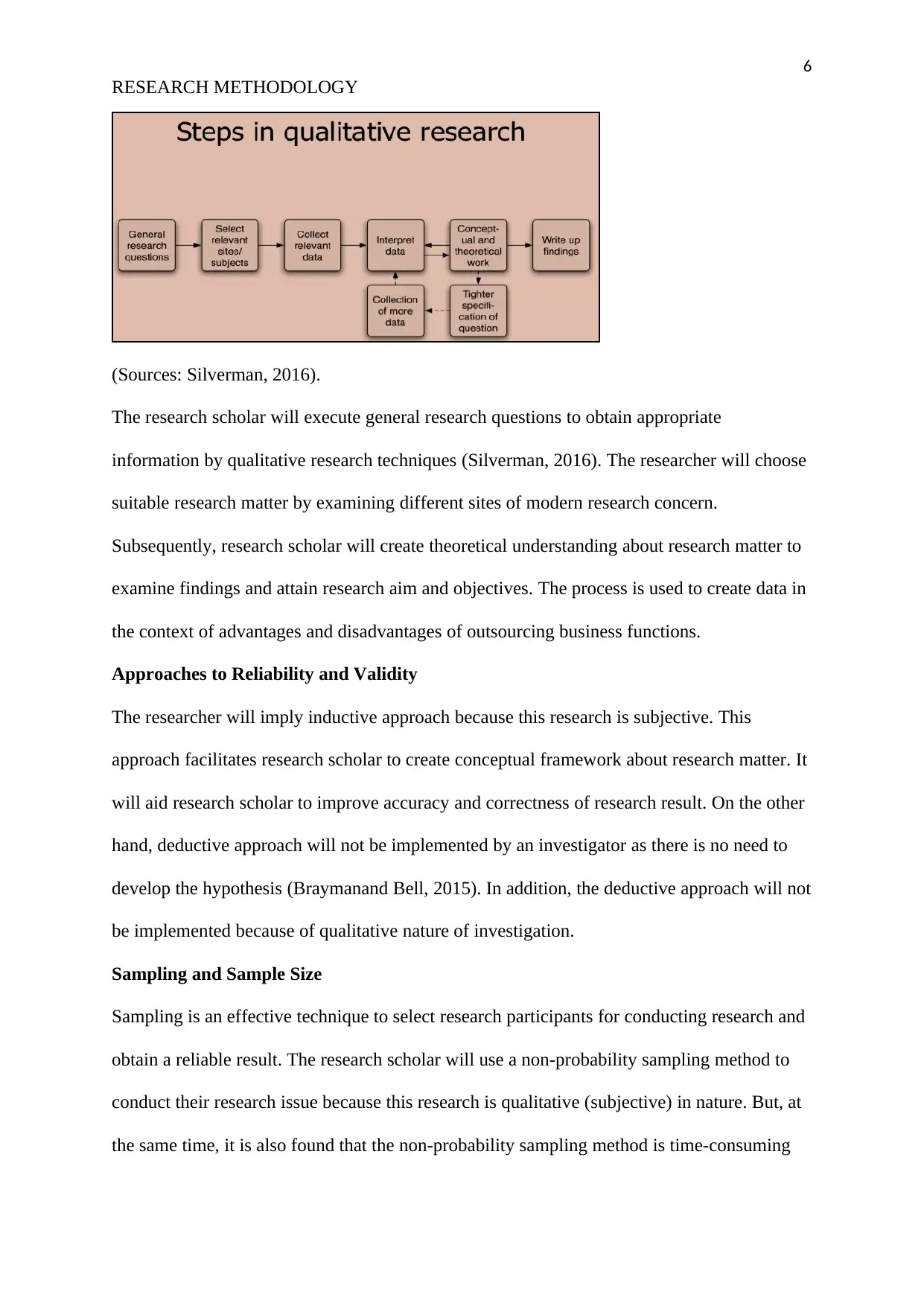
6
RESEARCH METHODOLOGY
(Sources: Silverman, 2016).
The research scholar will execute general research questions to obtain appropriate
information by qualitative research techniques (Silverman, 2016). The researcher will choose
suitable research matter by examining different sites of modern research concern.
Subsequently, research scholar will create theoretical understanding about research matter to
examine findings and attain research aim and objectives. The process is used to create data in
the context of advantages and disadvantages of outsourcing business functions.
Approaches to Reliability and Validity
The researcher will imply inductive approach because this research is subjective. This
approach facilitates research scholar to create conceptual framework about research matter. It
will aid research scholar to improve accuracy and correctness of research result. On the other
hand, deductive approach will not be implemented by an investigator as there is no need to
develop the hypothesis (Braymanand Bell, 2015). In addition, the deductive approach will not
be implemented because of qualitative nature of investigation.
Sampling and Sample Size
Sampling is an effective technique to select research participants for conducting research and
obtain a reliable result. The research scholar will use a non-probability sampling method to
conduct their research issue because this research is qualitative (subjective) in nature. But, at
the same time, it is also found that the non-probability sampling method is time-consuming
RESEARCH METHODOLOGY
(Sources: Silverman, 2016).
The research scholar will execute general research questions to obtain appropriate
information by qualitative research techniques (Silverman, 2016). The researcher will choose
suitable research matter by examining different sites of modern research concern.
Subsequently, research scholar will create theoretical understanding about research matter to
examine findings and attain research aim and objectives. The process is used to create data in
the context of advantages and disadvantages of outsourcing business functions.
Approaches to Reliability and Validity
The researcher will imply inductive approach because this research is subjective. This
approach facilitates research scholar to create conceptual framework about research matter. It
will aid research scholar to improve accuracy and correctness of research result. On the other
hand, deductive approach will not be implemented by an investigator as there is no need to
develop the hypothesis (Braymanand Bell, 2015). In addition, the deductive approach will not
be implemented because of qualitative nature of investigation.
Sampling and Sample Size
Sampling is an effective technique to select research participants for conducting research and
obtain a reliable result. The research scholar will use a non-probability sampling method to
conduct their research issue because this research is qualitative (subjective) in nature. But, at
the same time, it is also found that the non-probability sampling method is time-consuming
⊘ This is a preview!⊘
Do you want full access?
Subscribe today to unlock all pages.

Trusted by 1+ million students worldwide
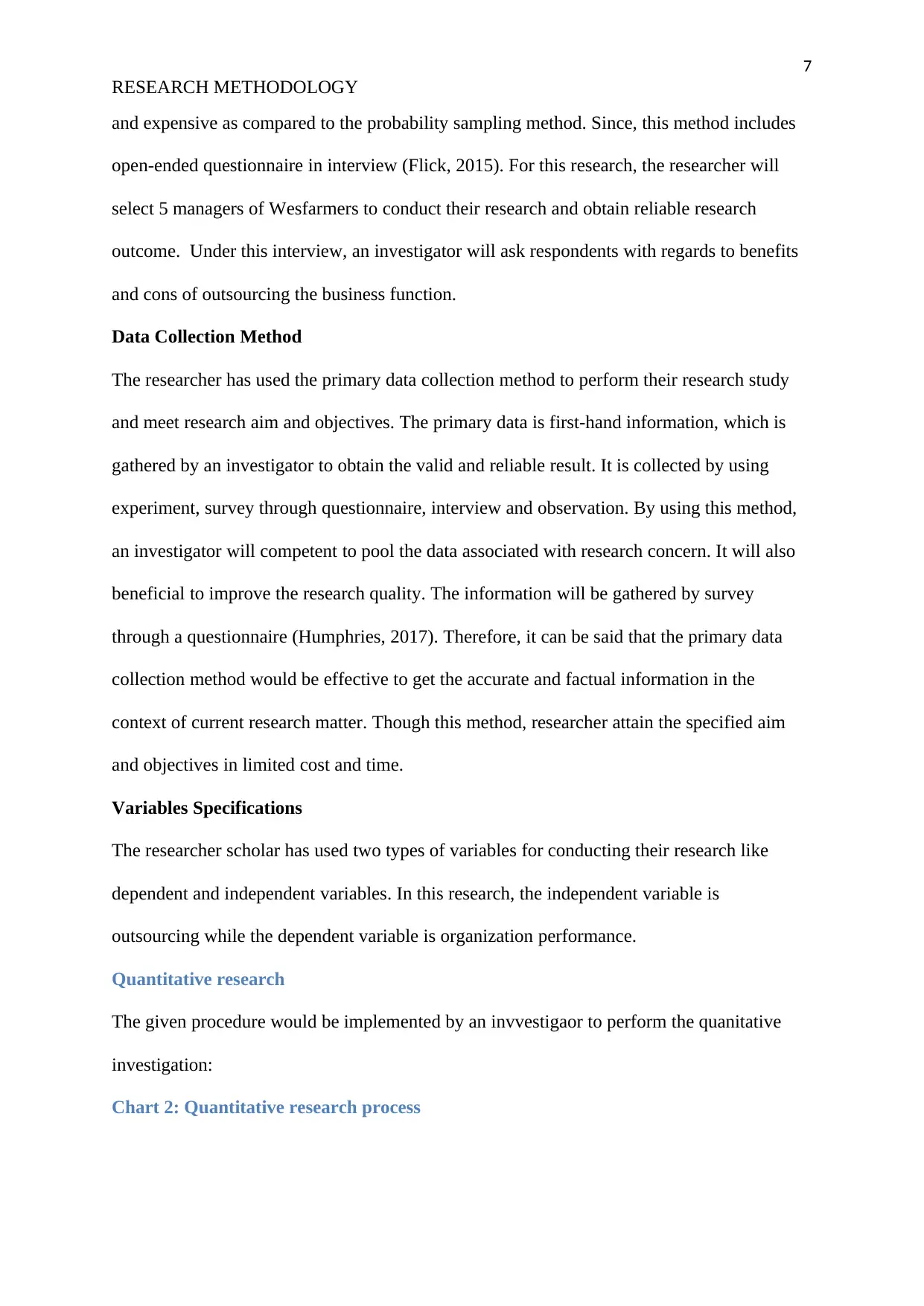
7
RESEARCH METHODOLOGY
and expensive as compared to the probability sampling method. Since, this method includes
open-ended questionnaire in interview (Flick, 2015). For this research, the researcher will
select 5 managers of Wesfarmers to conduct their research and obtain reliable research
outcome. Under this interview, an investigator will ask respondents with regards to benefits
and cons of outsourcing the business function.
Data Collection Method
The researcher has used the primary data collection method to perform their research study
and meet research aim and objectives. The primary data is first-hand information, which is
gathered by an investigator to obtain the valid and reliable result. It is collected by using
experiment, survey through questionnaire, interview and observation. By using this method,
an investigator will competent to pool the data associated with research concern. It will also
beneficial to improve the research quality. The information will be gathered by survey
through a questionnaire (Humphries, 2017). Therefore, it can be said that the primary data
collection method would be effective to get the accurate and factual information in the
context of current research matter. Though this method, researcher attain the specified aim
and objectives in limited cost and time.
Variables Specifications
The researcher scholar has used two types of variables for conducting their research like
dependent and independent variables. In this research, the independent variable is
outsourcing while the dependent variable is organization performance.
Quantitative research
The given procedure would be implemented by an invvestigaor to perform the quanitative
investigation:
Chart 2: Quantitative research process
RESEARCH METHODOLOGY
and expensive as compared to the probability sampling method. Since, this method includes
open-ended questionnaire in interview (Flick, 2015). For this research, the researcher will
select 5 managers of Wesfarmers to conduct their research and obtain reliable research
outcome. Under this interview, an investigator will ask respondents with regards to benefits
and cons of outsourcing the business function.
Data Collection Method
The researcher has used the primary data collection method to perform their research study
and meet research aim and objectives. The primary data is first-hand information, which is
gathered by an investigator to obtain the valid and reliable result. It is collected by using
experiment, survey through questionnaire, interview and observation. By using this method,
an investigator will competent to pool the data associated with research concern. It will also
beneficial to improve the research quality. The information will be gathered by survey
through a questionnaire (Humphries, 2017). Therefore, it can be said that the primary data
collection method would be effective to get the accurate and factual information in the
context of current research matter. Though this method, researcher attain the specified aim
and objectives in limited cost and time.
Variables Specifications
The researcher scholar has used two types of variables for conducting their research like
dependent and independent variables. In this research, the independent variable is
outsourcing while the dependent variable is organization performance.
Quantitative research
The given procedure would be implemented by an invvestigaor to perform the quanitative
investigation:
Chart 2: Quantitative research process
Paraphrase This Document
Need a fresh take? Get an instant paraphrase of this document with our AI Paraphraser
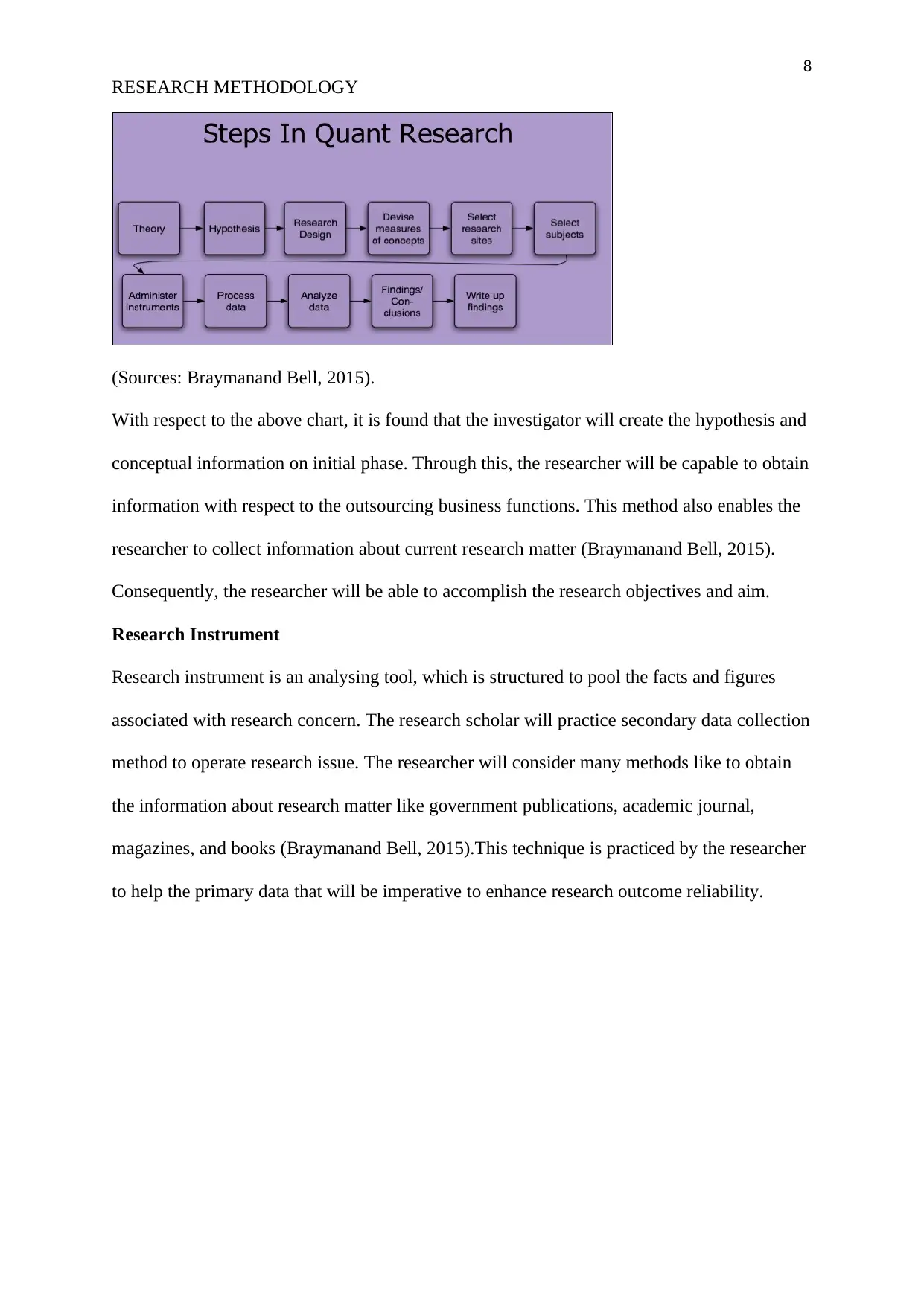
8
RESEARCH METHODOLOGY
(Sources: Braymanand Bell, 2015).
With respect to the above chart, it is found that the investigator will create the hypothesis and
conceptual information on initial phase. Through this, the researcher will be capable to obtain
information with respect to the outsourcing business functions. This method also enables the
researcher to collect information about current research matter (Braymanand Bell, 2015).
Consequently, the researcher will be able to accomplish the research objectives and aim.
Research Instrument
Research instrument is an analysing tool, which is structured to pool the facts and figures
associated with research concern. The research scholar will practice secondary data collection
method to operate research issue. The researcher will consider many methods like to obtain
the information about research matter like government publications, academic journal,
magazines, and books (Braymanand Bell, 2015).This technique is practiced by the researcher
to help the primary data that will be imperative to enhance research outcome reliability.
RESEARCH METHODOLOGY
(Sources: Braymanand Bell, 2015).
With respect to the above chart, it is found that the investigator will create the hypothesis and
conceptual information on initial phase. Through this, the researcher will be capable to obtain
information with respect to the outsourcing business functions. This method also enables the
researcher to collect information about current research matter (Braymanand Bell, 2015).
Consequently, the researcher will be able to accomplish the research objectives and aim.
Research Instrument
Research instrument is an analysing tool, which is structured to pool the facts and figures
associated with research concern. The research scholar will practice secondary data collection
method to operate research issue. The researcher will consider many methods like to obtain
the information about research matter like government publications, academic journal,
magazines, and books (Braymanand Bell, 2015).This technique is practiced by the researcher
to help the primary data that will be imperative to enhance research outcome reliability.

9
RESEARCH METHODOLOGY
Quantitative Data Analysis Process
The given process of quantitative data analysis will be used by an investigator:
Chart 3: Quantitative data analysis process
(Sources: Zikmud, 2012).
From the above discussion, it can that researcher will address the data at the initial stage.
Consequently, the researcher will choose appropriate data from the specified sample size.
This method supports research scholar to enhance their understanding about frequency, mean,
and data collection method to obtain accurate information in the context of current research
concern (Zikmud, 2012). The researcher will use Ms-excel software to evaluate gathered
information by tables, charts, and graphs. This technique helps research scholar to examine
collected information and get a reliable outcome.
Sampling and Sample Size
The researcher will use probability sampling method to obtain information from specified
research candidates and obtain the reliable result (Sherri, 2015).This technique will help to
collect the views and opinion of the research candidates toward the specified research matter.
Moreover, the research candidates support to decline biases from the research study. The
researcher will choose 50 employees for conducting their research study and obtain a reliable
result. It would also help to attain the specified research aim and objectives in the least time
and cost.
RESEARCH METHODOLOGY
Quantitative Data Analysis Process
The given process of quantitative data analysis will be used by an investigator:
Chart 3: Quantitative data analysis process
(Sources: Zikmud, 2012).
From the above discussion, it can that researcher will address the data at the initial stage.
Consequently, the researcher will choose appropriate data from the specified sample size.
This method supports research scholar to enhance their understanding about frequency, mean,
and data collection method to obtain accurate information in the context of current research
concern (Zikmud, 2012). The researcher will use Ms-excel software to evaluate gathered
information by tables, charts, and graphs. This technique helps research scholar to examine
collected information and get a reliable outcome.
Sampling and Sample Size
The researcher will use probability sampling method to obtain information from specified
research candidates and obtain the reliable result (Sherri, 2015).This technique will help to
collect the views and opinion of the research candidates toward the specified research matter.
Moreover, the research candidates support to decline biases from the research study. The
researcher will choose 50 employees for conducting their research study and obtain a reliable
result. It would also help to attain the specified research aim and objectives in the least time
and cost.
⊘ This is a preview!⊘
Do you want full access?
Subscribe today to unlock all pages.

Trusted by 1+ million students worldwide
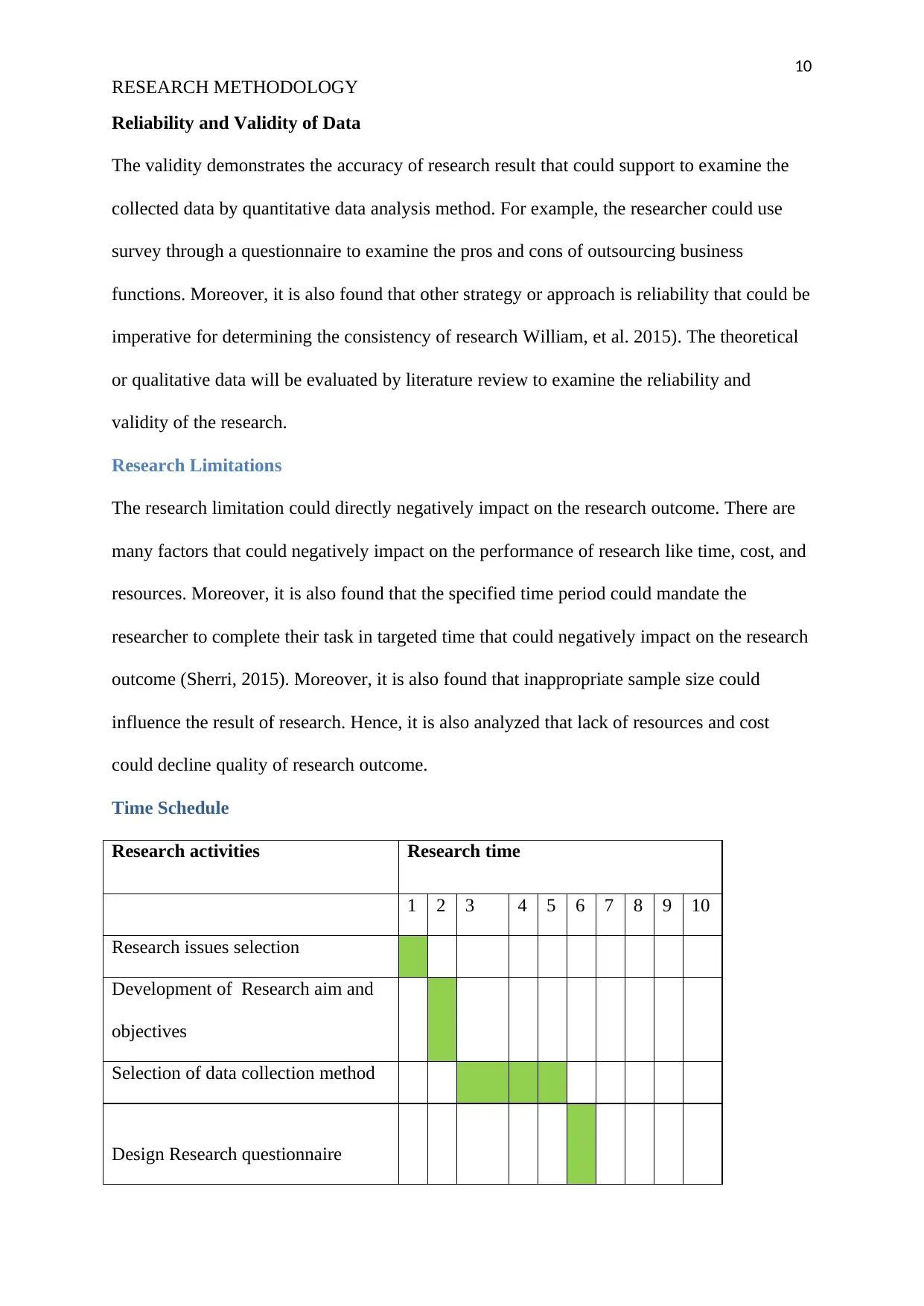
10
RESEARCH METHODOLOGY
Reliability and Validity of Data
The validity demonstrates the accuracy of research result that could support to examine the
collected data by quantitative data analysis method. For example, the researcher could use
survey through a questionnaire to examine the pros and cons of outsourcing business
functions. Moreover, it is also found that other strategy or approach is reliability that could be
imperative for determining the consistency of research William, et al. 2015). The theoretical
or qualitative data will be evaluated by literature review to examine the reliability and
validity of the research.
Research Limitations
The research limitation could directly negatively impact on the research outcome. There are
many factors that could negatively impact on the performance of research like time, cost, and
resources. Moreover, it is also found that the specified time period could mandate the
researcher to complete their task in targeted time that could negatively impact on the research
outcome (Sherri, 2015). Moreover, it is also found that inappropriate sample size could
influence the result of research. Hence, it is also analyzed that lack of resources and cost
could decline quality of research outcome.
Time Schedule
Research activities Research time
1 2 3 4 5 6 7 8 9 10
Research issues selection
Development of Research aim and
objectives
Selection of data collection method
Design Research questionnaire
RESEARCH METHODOLOGY
Reliability and Validity of Data
The validity demonstrates the accuracy of research result that could support to examine the
collected data by quantitative data analysis method. For example, the researcher could use
survey through a questionnaire to examine the pros and cons of outsourcing business
functions. Moreover, it is also found that other strategy or approach is reliability that could be
imperative for determining the consistency of research William, et al. 2015). The theoretical
or qualitative data will be evaluated by literature review to examine the reliability and
validity of the research.
Research Limitations
The research limitation could directly negatively impact on the research outcome. There are
many factors that could negatively impact on the performance of research like time, cost, and
resources. Moreover, it is also found that the specified time period could mandate the
researcher to complete their task in targeted time that could negatively impact on the research
outcome (Sherri, 2015). Moreover, it is also found that inappropriate sample size could
influence the result of research. Hence, it is also analyzed that lack of resources and cost
could decline quality of research outcome.
Time Schedule
Research activities Research time
1 2 3 4 5 6 7 8 9 10
Research issues selection
Development of Research aim and
objectives
Selection of data collection method
Design Research questionnaire
Paraphrase This Document
Need a fresh take? Get an instant paraphrase of this document with our AI Paraphraser
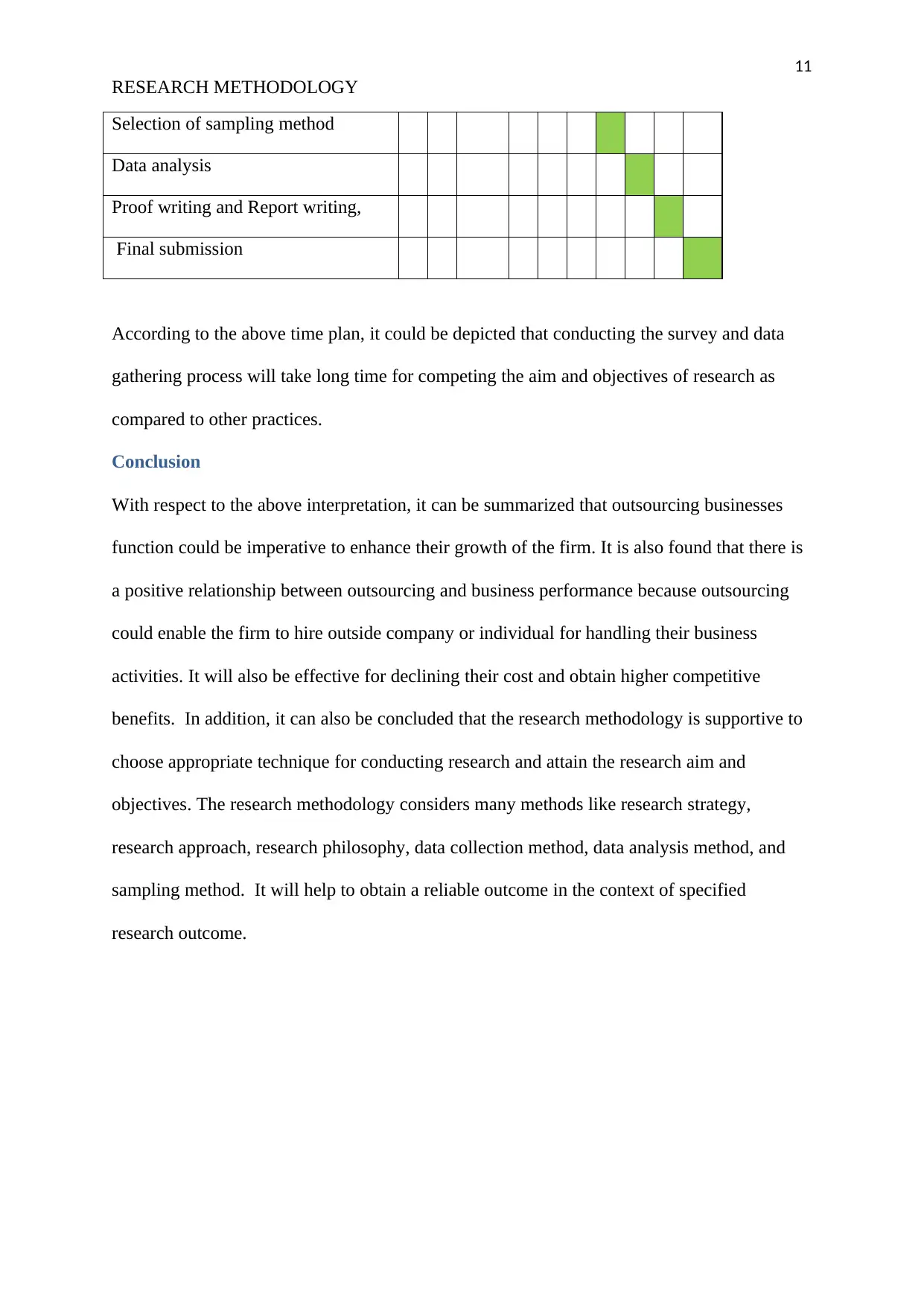
11
RESEARCH METHODOLOGY
Selection of sampling method
Data analysis
Proof writing and Report writing,
Final submission
According to the above time plan, it could be depicted that conducting the survey and data
gathering process will take long time for competing the aim and objectives of research as
compared to other practices.
Conclusion
With respect to the above interpretation, it can be summarized that outsourcing businesses
function could be imperative to enhance their growth of the firm. It is also found that there is
a positive relationship between outsourcing and business performance because outsourcing
could enable the firm to hire outside company or individual for handling their business
activities. It will also be effective for declining their cost and obtain higher competitive
benefits. In addition, it can also be concluded that the research methodology is supportive to
choose appropriate technique for conducting research and attain the research aim and
objectives. The research methodology considers many methods like research strategy,
research approach, research philosophy, data collection method, data analysis method, and
sampling method. It will help to obtain a reliable outcome in the context of specified
research outcome.
RESEARCH METHODOLOGY
Selection of sampling method
Data analysis
Proof writing and Report writing,
Final submission
According to the above time plan, it could be depicted that conducting the survey and data
gathering process will take long time for competing the aim and objectives of research as
compared to other practices.
Conclusion
With respect to the above interpretation, it can be summarized that outsourcing businesses
function could be imperative to enhance their growth of the firm. It is also found that there is
a positive relationship between outsourcing and business performance because outsourcing
could enable the firm to hire outside company or individual for handling their business
activities. It will also be effective for declining their cost and obtain higher competitive
benefits. In addition, it can also be concluded that the research methodology is supportive to
choose appropriate technique for conducting research and attain the research aim and
objectives. The research methodology considers many methods like research strategy,
research approach, research philosophy, data collection method, data analysis method, and
sampling method. It will help to obtain a reliable outcome in the context of specified
research outcome.
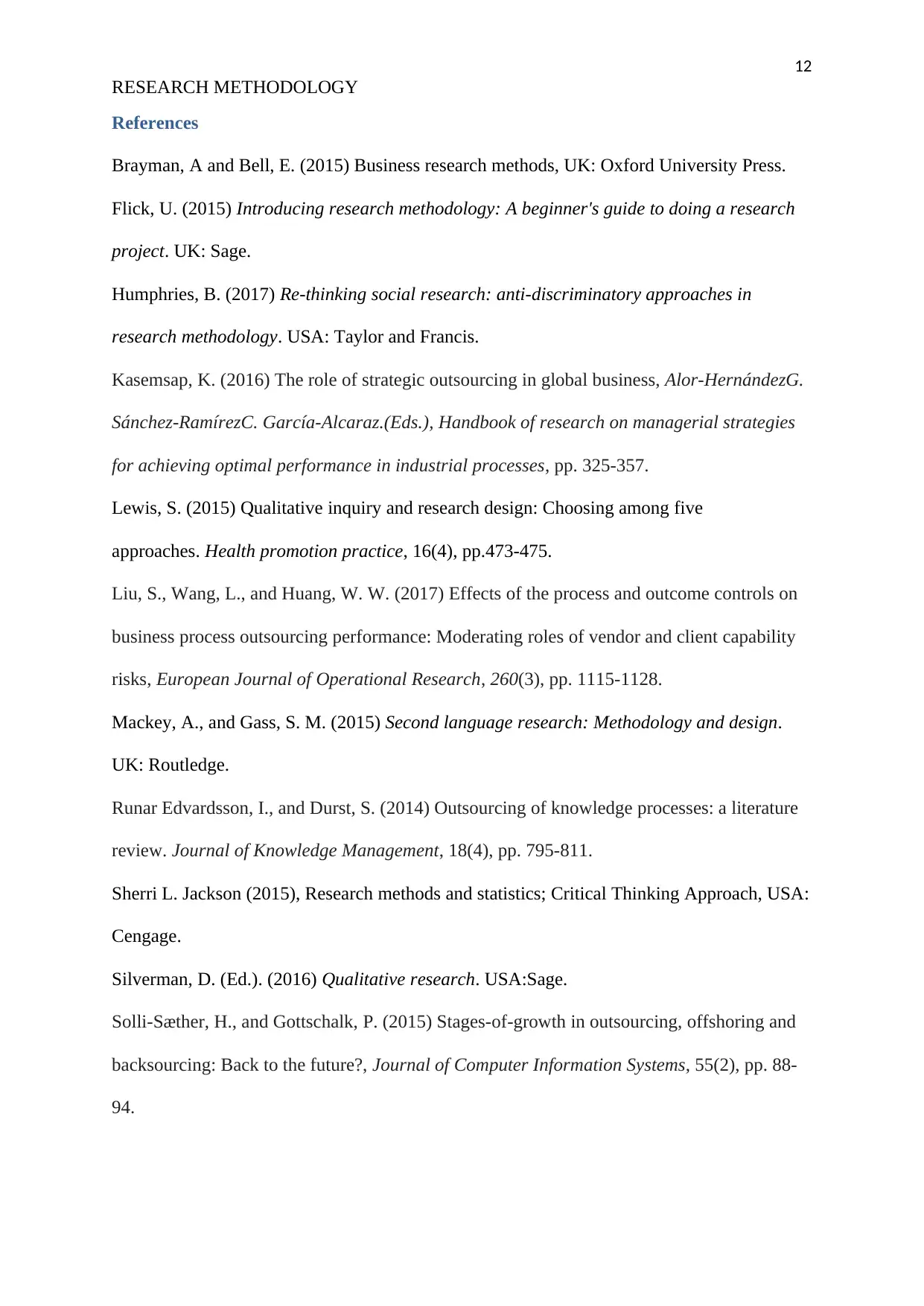
12
RESEARCH METHODOLOGY
References
Brayman, A and Bell, E. (2015) Business research methods, UK: Oxford University Press.
Flick, U. (2015) Introducing research methodology: A beginner's guide to doing a research
project. UK: Sage.
Humphries, B. (2017) Re-thinking social research: anti-discriminatory approaches in
research methodology. USA: Taylor and Francis.
Kasemsap, K. (2016) The role of strategic outsourcing in global business, Alor-HernándezG.
Sánchez-RamírezC. García-Alcaraz.(Eds.), Handbook of research on managerial strategies
for achieving optimal performance in industrial processes, pp. 325-357.
Lewis, S. (2015) Qualitative inquiry and research design: Choosing among five
approaches. Health promotion practice, 16(4), pp.473-475.
Liu, S., Wang, L., and Huang, W. W. (2017) Effects of the process and outcome controls on
business process outsourcing performance: Moderating roles of vendor and client capability
risks, European Journal of Operational Research, 260(3), pp. 1115-1128.
Mackey, A., and Gass, S. M. (2015) Second language research: Methodology and design.
UK: Routledge.
Runar Edvardsson, I., and Durst, S. (2014) Outsourcing of knowledge processes: a literature
review. Journal of Knowledge Management, 18(4), pp. 795-811.
Sherri L. Jackson (2015), Research methods and statistics; Critical Thinking Approach, USA:
Cengage.
Silverman, D. (Ed.). (2016) Qualitative research. USA:Sage.
Solli-Sæther, H., and Gottschalk, P. (2015) Stages-of-growth in outsourcing, offshoring and
backsourcing: Back to the future?, Journal of Computer Information Systems, 55(2), pp. 88-
94.
RESEARCH METHODOLOGY
References
Brayman, A and Bell, E. (2015) Business research methods, UK: Oxford University Press.
Flick, U. (2015) Introducing research methodology: A beginner's guide to doing a research
project. UK: Sage.
Humphries, B. (2017) Re-thinking social research: anti-discriminatory approaches in
research methodology. USA: Taylor and Francis.
Kasemsap, K. (2016) The role of strategic outsourcing in global business, Alor-HernándezG.
Sánchez-RamírezC. García-Alcaraz.(Eds.), Handbook of research on managerial strategies
for achieving optimal performance in industrial processes, pp. 325-357.
Lewis, S. (2015) Qualitative inquiry and research design: Choosing among five
approaches. Health promotion practice, 16(4), pp.473-475.
Liu, S., Wang, L., and Huang, W. W. (2017) Effects of the process and outcome controls on
business process outsourcing performance: Moderating roles of vendor and client capability
risks, European Journal of Operational Research, 260(3), pp. 1115-1128.
Mackey, A., and Gass, S. M. (2015) Second language research: Methodology and design.
UK: Routledge.
Runar Edvardsson, I., and Durst, S. (2014) Outsourcing of knowledge processes: a literature
review. Journal of Knowledge Management, 18(4), pp. 795-811.
Sherri L. Jackson (2015), Research methods and statistics; Critical Thinking Approach, USA:
Cengage.
Silverman, D. (Ed.). (2016) Qualitative research. USA:Sage.
Solli-Sæther, H., and Gottschalk, P. (2015) Stages-of-growth in outsourcing, offshoring and
backsourcing: Back to the future?, Journal of Computer Information Systems, 55(2), pp. 88-
94.
⊘ This is a preview!⊘
Do you want full access?
Subscribe today to unlock all pages.

Trusted by 1+ million students worldwide
1 out of 13
Related Documents
Your All-in-One AI-Powered Toolkit for Academic Success.
+13062052269
info@desklib.com
Available 24*7 on WhatsApp / Email
![[object Object]](/_next/static/media/star-bottom.7253800d.svg)
Unlock your academic potential
Copyright © 2020–2025 A2Z Services. All Rights Reserved. Developed and managed by ZUCOL.




